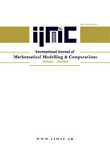فهرست مطالب

مجله بین المللی محاسبات و مدل سازی ریاضی
سال سوم شماره 1 (Winter 2013)
- تاریخ انتشار: 1392/02/25
- تعداد عناوین: 8
-
Page 1This paper is evolved to have insight of Plankton-Nutrients interactions in the presence of delay in the growth term of phytoplankton species. The conditions for asymptotic stability about endemic equilibrium are derived in the absence of delay.The Nyquist criteria is used to estimate the length of delay to preserve stability. Analytic criterion for the existence of hopf-bifurcation is also discussed.Keywords: Planktons, Nyquist Criterion, Length of Delay, Stability, Hopf
-
Page 11The spline collocation method is used to approximate solutions of boundary value problems. The convergence analysis is given and the method is shown to have second-order convergence. A numerical illustration is given to show the pertinent features of the technique.Keywords: Boundary, value problems, Collocation method, Spline interpolant
-
Page 25We develope a numerical method based on B-spline collocation method to solve linear Klein-Gordon equation. The proposed scheme is unconditionally stable. The results of numerical experiments have been compared with the exact solution to show the efficiency of the method computationally. Easy and economical implementation is the strength of this approach.Keywords: Klein, Gordon equation, Collocation, Cubic B, spline method, Stability
-
Page 35In this paper we consider multivariate Lagrange mean-value interpolation problem، where interpolation parameters are integrals over spheres. We have concentric spheres. Indeed، we consider the problem in three variables when it is not correct.Keywords: Lagrange interpolation, mean, value interpolation, multivariate polynomial, sphere
-
Page 43Integrating various suppliers to satisfy market demand is of great importance for e ective supply chain management. In this paper, we consider the ODE-PDE model of supply chain and apply a classical explicit fourth-order Runge-Kutta scheme for the related ODE model of suppliers. Also, the convergence of the proposed method is proved. Finally a numerical example is studied to demonstrate the accuracy of the proposed method with different choices of time and space meshes.
-
Page 51In this work, the Blasius equation is studied. Homotopy perturbation method (HPM) and homotopy analysis method (HAM) are applied to obtain its solution. Comparison with variational iteration method (VIM) is made to highlight the significant features of employed methods and their capability of handling nonlinear problems. The outcome shows the success of (HPM) and (HAM) for solving nonlinear problems arising in fluid mechanics.Keywords: Blasius equation, HPM, HAM, VIM
-
Page 59In this paper we intend to offer new numerical methods to solve the fuzzy Fredholm- Volterra integral equations of the first kind $(FVFIE-1)$. Some examples are investigated to verify convergence results and to illustrate the efficiently of the methods.Keywords: Airfoil polynomials, Jacobi polynomials, Fuzzy
-
Page 71Mobile sensor networks rely heavily on inter-sensor connectivity for collection of data. Nodes in these networks monitor di erent regions of an area of interest and collectively present a global overview of some monitored activities or phenomena. A failure of a sensor leads to loss of connectivity and may cause partitioning of the network into disjoint segments. A number of approaches have been recently proposed that pursue node relocation in order to restore connectivity. DCR is a distributed partitioning detection and connectivity restora- tion algorithm to tolerate the failure of sensors. DCR proactively identi es sensors that are critical to the network connectivity based on local topological information, and designates appropriate, preferably non-critical, backup nodes. Upon failure detection, the backup sensor initiates a recovery process that may involve coordinated relocation of multiple sensors. Here we proposed Energy aware Distributed partitioning detection and connectivity restoration al- gorithm (EDCR) that is an improvement of DCR algorithm. Therefore reducing the message exchange overhead, lower energy consumption, and thus will increase the network lifetimeKeywords: Wireless sensor networks, Connectivity restoration, Fault recovery, Node relocation, Enargy aware

